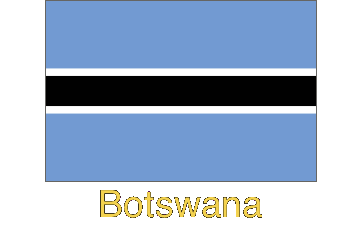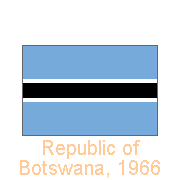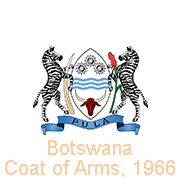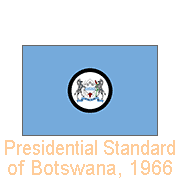Flags from Botswana

A Flag history of Botswana
In the late 19th century, Batswana leaders Khama III, Bathoen and Sebele appealed to the British Government for assistance when Ndebele (or Matabele), a people of Zulu stock, moved into what is now western Zimbabwe and were making incursions into Tswana lands. Dutch Boer settlers were coming in from the Transvaal to the east, and German immigrants from the west. On 31 March 1885, the northern area, north of the Molopo River, corresponding to modern Botswana, came under direct British administration as the Bechuanaland Protectorate. The Union Jack was from that time the flag, flying over the territory.
you may then send it as a postcard if you wish.
In 1931 the post of High Commissioner of Basutoland, Bechuanaland and Swaziland was created, responsible for the administration of the three British Protectorates in southern Africa. Based in South Africa, the High Commissioner was represented by a Resident Commissioner in each of the High Commission Territories. He flew a British Union Flag charged in the centre, on a white roundel, the letters H.C. in black, above the Imperial State Crown, within a garland of green laurel. The Union Jack remained the flag of Bechuanaland Protectorate until 1966 when the country became independent.
The National Flag of the Republic of Botswana was first hoisted at midnight on 30 September 1966 upon independence. Its colour was light blue, representing water and, specifically, rain, a precious resource in this dry land. A black band, framed in white, represented peace and harmony between people of African and European descent who reside in Botswana. This symbol was very relevant: in neighbouring South Africa and South African administered South West Africa (now Namibia) and “Apartheid” was still the policy of the land. An unrecognised white minority regime then ruled Rhodesia (now Zimbabwe) and Mozambique was still a Portuguese colony.
The coat of arms of Botswana was adopted on 25 January 1966, featuring a warrior’s shield supported by two zebras; the left one holding an elephant tusk representing the former ivory trade, and the right one an ear of sorghum, an important crop. The zebra’s black and white stripes also represented equality for and harmony among people of all colours. The shield featured three cogwheels for industry, a bull’s head for cattle rearing and three blue waves representing water. The country’s motto “Pula”, meaning “Rain”, a precious resource on the arid land, was displayed on a blue ribbon. It also represented good luck and became the name of the country’s currency. A Presidential Standard of the Republic of Botswana was designed consisting of a light blue field charged with a black-rimmed white circle containing the coat of arms of Botswana in the centre.





